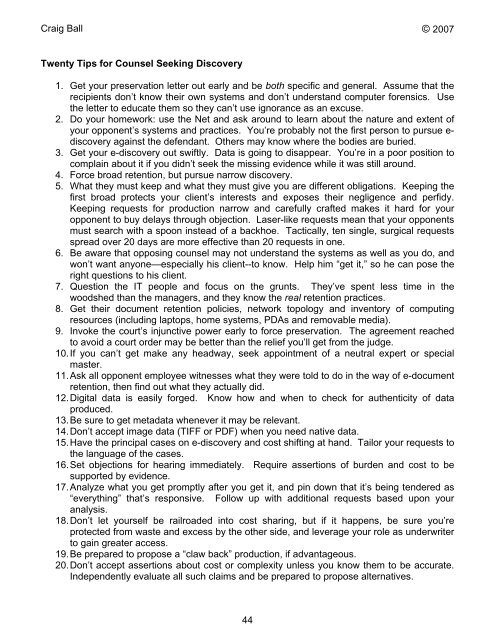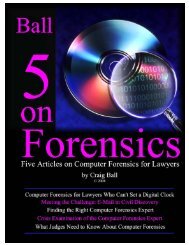Six Articles on Electronic - Craig Ball
Six Articles on Electronic - Craig Ball
Six Articles on Electronic - Craig Ball
You also want an ePaper? Increase the reach of your titles
YUMPU automatically turns print PDFs into web optimized ePapers that Google loves.
<strong>Craig</strong> <strong>Ball</strong> © 2007<br />
Twenty Tips for Counsel Seeking Discovery<br />
1. Get your preservati<strong>on</strong> letter out early and be both specific and general. Assume that the<br />
recipients d<strong>on</strong>’t know their own systems and d<strong>on</strong>’t understand computer forensics. Use<br />
the letter to educate them so they can’t use ignorance as an excuse.<br />
2. Do your homework: use the Net and ask around to learn about the nature and extent of<br />
your opp<strong>on</strong>ent’s systems and practices. You’re probably not the first pers<strong>on</strong> to pursue e-<br />
discovery against the defendant. Others may know where the bodies are buried.<br />
3. Get your e-discovery out swiftly. Data is going to disappear. You’re in a poor positi<strong>on</strong> to<br />
complain about it if you didn’t seek the missing evidence while it was still around.<br />
4. Force broad retenti<strong>on</strong>, but pursue narrow discovery.<br />
5. What they must keep and what they must give you are different obligati<strong>on</strong>s. Keeping the<br />
first broad protects your client’s interests and exposes their negligence and perfidy.<br />
Keeping requests for producti<strong>on</strong> narrow and carefully crafted makes it hard for your<br />
opp<strong>on</strong>ent to buy delays through objecti<strong>on</strong>. Laser-like requests mean that your opp<strong>on</strong>ents<br />
must search with a spo<strong>on</strong> instead of a backhoe. Tactically, ten single, surgical requests<br />
spread over 20 days are more effective than 20 requests in <strong>on</strong>e.<br />
6. Be aware that opposing counsel may not understand the systems as well as you do, and<br />
w<strong>on</strong>’t want any<strong>on</strong>e—especially his client--to know. Help him “get it,” so he can pose the<br />
right questi<strong>on</strong>s to his client.<br />
7. Questi<strong>on</strong> the IT people and focus <strong>on</strong> the grunts. They’ve spent less time in the<br />
woodshed than the managers, and they know the real retenti<strong>on</strong> practices.<br />
8. Get their document retenti<strong>on</strong> policies, network topology and inventory of computing<br />
resources (including laptops, home systems, PDAs and removable media).<br />
9. Invoke the court’s injunctive power early to force preservati<strong>on</strong>. The agreement reached<br />
to avoid a court order may be better than the relief you’ll get from the judge.<br />
10. If you can’t get make any headway, seek appointment of a neutral expert or special<br />
master.<br />
11. Ask all opp<strong>on</strong>ent employee witnesses what they were told to do in the way of e-document<br />
retenti<strong>on</strong>, then find out what they actually did.<br />
12. Digital data is easily forged. Know how and when to check for authenticity of data<br />
produced.<br />
13. Be sure to get metadata whenever it may be relevant.<br />
14. D<strong>on</strong>’t accept image data (TIFF or PDF) when you need native data.<br />
15. Have the principal cases <strong>on</strong> e-discovery and cost shifting at hand. Tailor your requests to<br />
the language of the cases.<br />
16. Set objecti<strong>on</strong>s for hearing immediately. Require asserti<strong>on</strong>s of burden and cost to be<br />
supported by evidence.<br />
17. Analyze what you get promptly after you get it, and pin down that it’s being tendered as<br />
“everything” that’s resp<strong>on</strong>sive. Follow up with additi<strong>on</strong>al requests based up<strong>on</strong> your<br />
analysis.<br />
18. D<strong>on</strong>’t let yourself be railroaded into cost sharing, but if it happens, be sure you’re<br />
protected from waste and excess by the other side, and leverage your role as underwriter<br />
to gain greater access.<br />
19. Be prepared to propose a “claw back” producti<strong>on</strong>, if advantageous.<br />
20. D<strong>on</strong>’t accept asserti<strong>on</strong>s about cost or complexity unless you know them to be accurate.<br />
Independently evaluate all such claims and be prepared to propose alternatives.<br />
44













